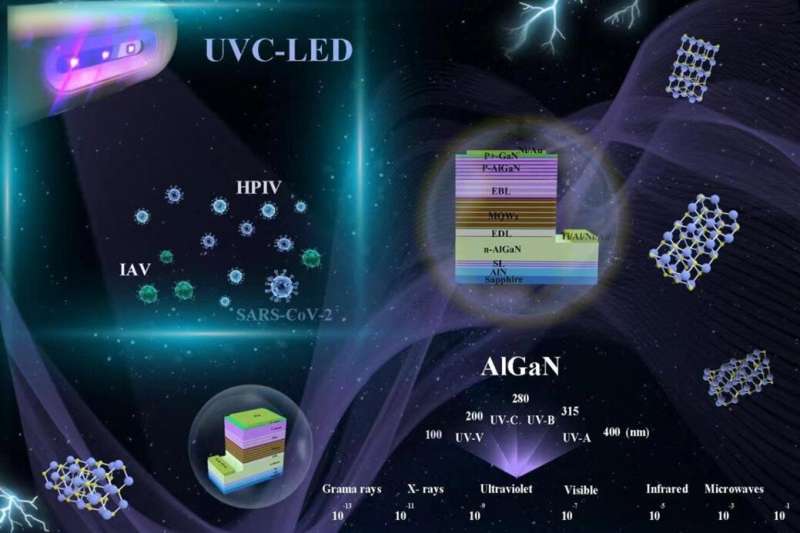This article has been reviewed according to Science X's editorial process and policies. Editors have highlighted the following attributes while ensuring the content's credibility:
fact-checked
proofread
Rapid inactivation of human respiratory RNA viruses by DUV LEDs

Human respiratory RNA viruses, such as SARS-CoV-2 and influenza A virus (IAV), spread rapidly in the human population by airway transmission and caused substantial morbidity, mortality, economic losses, and pandemic diseases worldwide. Hence, more efficient and broad-spectrum disinfection methods should be developed for surface and environmental disinfection to reduce the risk of human respiratory RNA virus transmission.
DUV light irradiation is an effective virus inactivation method through damaging viral genomes. Mercury lamps are conventionally used in virus disinfection but suffer the disadvantages of toxicity, fragility, bulkiness, short lifetime, and ozone production. Moreover, according to the Minamata Convention on Mercury, the manufacture, import, and export of a myriad of products containing mercury have been prohibited since 2020. Hence, an eco-friendly and efficient germicidal candidate is now eagerly demanded.
A DUV LED based on AlGaN, whose wavelength is tunable from 365 to 210 nm, is a perfect alternative to mercury lamps for sterilization because it is small in size, conserves energy, and is pollution-free.
AlGaN-based DUV LEDs are usually heteroepitaxially grown on an AlN/Sapphire template since AlN single-crystal substrates are too expensive. The HTA method may be the most promising to obtain high-quality AlN/Sapphire template for industrial application due to its simplicity, high efficiency, and stability. However, the HTA AlN/Sapphire template usually exhibits strong compressive stress (SCS), which significantly affects the upper AlGaN quality.
On one hand, the SCS can induce the Stranski-Krastanov (S-K) growth mode and result in 3D islands, leading to a high density of threading dislocations and rough surfaces. On the other hand, the SCS will cause a pulling effect, leading to composition nonuniformity and low p-doping efficiency. Furthermore, the SCS will very likely deteriorate the device during fabrication processes. Hence, relaxation of the SCS during epitaxy on the HTA AlN/Sapphire template is necessary.
The authors of an article now published in Opto-Electronic Advances carried out research on the stress engineering, device preparation, and the inactivation efficiency on human respiratory RNA viruses by epitaxial AlGaN-based DUV LEDs on SCS AlN/sapphire template substrates. They found that by inserting a superlattice structure between the SCS AlN/sapphire substrate and the AlGaN epitaxial layer, the SCS of the epitaxial layer of the substrate can be effectively relieved, so that the dislocation density of the AlGaN epitaxial layer is reduced by more than an order of magnitude and atomic level flat surface can be obtained, improving the quality of the epitaxial LED interface.
Based on this method, the research team prepared AlGaN based DUV LEDs with different peak wavelengths, including 256, 265, and 278 nm, corresponding to optical power of 6.8, 9.6 and 12.5 mW at 100 mA. They also studied the disinfection and sterilization effect of different wavelengths on human respiratory RNA virus SARS-CoV-2, IAV and human parainfluenza virus (HPIV) under the same optical power density (0.8 mW/cm2).
The results indicate that when the virus concentration is 3.8×105 PFU/mL, all wavelength LEDs can 100% disinfection and sterilization SARS-CoV-2 and IAV within 60 seconds. Among them, 256 nm-LED can disinfect and sterilize SARS-CoV-2 and IAV 100% in 10 seconds, showing higher disinfection and sterilization efficiency than long wavelength LEDs. In addition, 256 nm-LED also shows excellent disinfection and sterilization effect under higher virus concentration and different virus attachment surface environments.
These results will help DUV LEDs disinfect viruses in a more portable, environmentally friendly, broad-spectrum and efficient manner.
More information: Ke Jiang et al, Rapid inactivation of human respiratory RNA viruses by deep ultraviolet irradiation from light-emitting diodes on a high-temperature-annealed AlN/Sapphire template, Opto-Electronic Advances (2023). DOI: 10.29026/oea.2023.230004. www.oejournal.org/article/doi/ … 9026/oea.2023.230004


















